
Fire
COVID-19 Los Angeles OPMACS

The Los Angeles Operational Area Multi-Agency Coordination System (OPMACS) was designed and developed to assist the thirty fire departments in Los Angeles County with a strategic common operating picture for daily situational awareness in dealing with the COVID-19 pandemic. Processes, procedures, and information systems were developed to aid daily activity pertaining to the status of fire department personnel, availability of personal protective equipment, response activity, and staffing issues with a potential impact to fire protection and emergency medical service delivery.
The project accomplished: a) integrated common operating picture for advanced planning and decision-making; b) development of a "dashboard" for real-time situational awareness; c) early identification of potential challenges; d) the ability to provide seamless mutual aid assistance to neighboring fire departments for fire protection and life safety services; e) regular information sharing for best practices; and f) model for future interagency collaboration dealing with major issues. The OPMACS project is currently on-going and has proven to be an asset as we continue to address the COVID-19 pandemic.
LACoFD COVID-19 Cost Recovery
Fire Department incurred millions of dollars in COVID-19 costs that were eligible for cost recovery through Coronavirus Aid, Relief and Economic Security funding. The COVID-19 Cost Recovery Project included developing and disseminating detailed instructions for tracking hours spent on COVID-19 related activities, collaborating with internal stakeholders to ensure appropriation documentation to support costs, reviewing hours reported for accuracy, downloading numerous reports and timekeeping documentation from department and County systems, obtaining cost information for items purchased, and preparing detailed spreadsheets to report the costs incurred.
The project was successfully completed while the staff involved handled competing priorities such as year-end closing, revisions to claiming instructions, and the complexities of coordinating work with staff in remote locations. The Fire Department is expected to recover $20 million in cost from the CARES funding for Fiscal Year 2019-20.
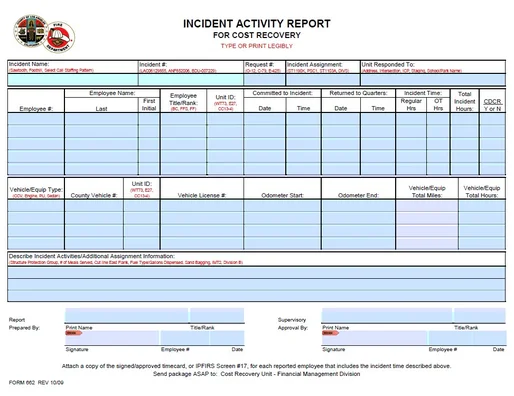
LACoFD COVID-19 Safety Awareness Campaign
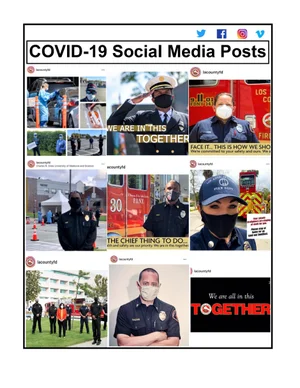
To further support the County's objective of prompting safety during the COVID-19 global pandemic, the Fire Department's Executive Support Division's Communications Section and Public Information Office created several social media posts, providing tips on staying healthy and preventing tips on staying healthy and preventing community spread. Additionally, the COVID-19 safety awareness campaign features various Department team member demonstrating safety protocols in place to protect both residents and first responders themselves.
The campaign emphasizes the importance of adhering to safety protocols while also showing how our procedures and policies align with the Fire Department's core values of caring, commitment, community, courage, integrity, and teamwork.
Access the video at: https://www.facebook.com/watch/?v=218321709224302
LACoFD Firefighter Trainee Recruit Academy
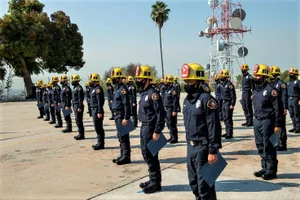
The Los Angeles County Fire Department made several adjustments to our Firefighter Trainee Recruit Academy to ensure we had the ability to continue with the academy while maintaining a COVID-19 safe environment. The Department opted to sequester the firefighter trainees and the training staff by securing hotel accommodations. This was a monumental task under the current conditions, within extremely tight deadlines, and included simultaneous academies. The Department also implemented COVID-19 precautions, such as disinfecting all areas at the beginning and the end of each day, wiping down all exercise equipment after each use, wearing masks in classroom settings, taking and tracking body temperature readings every morning, and limiting group size in common areas.
When feasible, lectures and presentations were held outdoors. The Department also rented portable hand washing stations that were placed throughout the training facilities. Due to these efforts, the Department reported zero firefighter trainees with COVID-19 symptoms during the academy. To date, the Department has been able to successfully graduate almost 150 firefighter trainees during a time when several agencies have postponed their recruit academies.
LACoFD Health Programs Office (HPO)

The Fire Department’s Health Program Office (HPO), historically, was responsible for ensuring that Department staff had proper vaccinations and followed up on any occupational infectious disease exposures. In light of the pandemic, the HPO, over a period of two weeks, brought in a new electronic platform that is capable of monitoring the more than 4,000 Department employees for any symptoms of COVID-19. Additionally, the HPO has taken on the responsibility of COVID-19 testing, contact tracing, and following the health for our entire Department.
To date, they have handled more than 12,000 suspected COVID-19 exposures, performed more than 2,000 COVID-19 PCR tests, managed more than 150 Department members through the course of their COVID-19 illness, and performed the largest prehospital seroprevalence study of COVID-19 antibodies in the United States.
(Note: Photo was taken before masks were required.)
LACoFD IMT Support-DPH COVID-19 Logistics/Housing
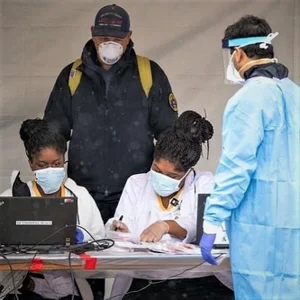
The Fire Chief assigned Incident Management Team 1 (IMT-1) to support the Department of Health Services (DHS) and the Department of Public Health (DPH) in mid-March. IMT-1 (75 people) deployed to the Long Beach Convention Center to support the receiving, storage, packaging, and distribution of Personal Protective Equipment Countywide. In early May, logistics operations transitioned from Long Beach to the Los Angeles Unified School District and the Fire Department handed operations back to DHS and DPH. IMT-1 distributed more than 15 million items in over 3,500 shipments to over 1,200 different locations countywide. In late March, Chief Daryl Osby redirected IMT-1 to support the Los Angeles Homeless Services Authority and the Los Angeles County Homeless Initiative to help stand up hotels for the Office of Public and Indian Housing (PIH) as part of the Statewide initiative, Project Room Key. Through mid-May, IMT-1 helped to successfully open 26 hotels with 2,300 rooms sheltering more than 2,000 PIH.
In early April, a portion of IMT-1 was reassigned to assist Dr. Clayton Kazan, Medical Director, his team, and nearly 75 lifeguards with the management of COVID-19 testing sites. Together, over a six-week period, they oversaw the operation of 32 testing sites, ten of which were drive-up sites, testing more than 128,000 County residents. On May 15, 2020, the IMT-1 handed testing site management over to DHS. Here is a video link the Lifeguard members created: vimeo.com
LACoFD Online Purchase Requisition System
The recently developed Fire Department Online Purchase Requisition System (OPRS) is an electronic system used by staff to request non-stock supplies and services (S&S).Prior to this system, requests for non-stock S&S were submitted via a paper form that required multiple hard signatures. Requests would take multiple days as the paper form had to be submitted through multiple approval layers before reaching Procurement. The paper form was often lost in transit, which required staff to resubmit requests.
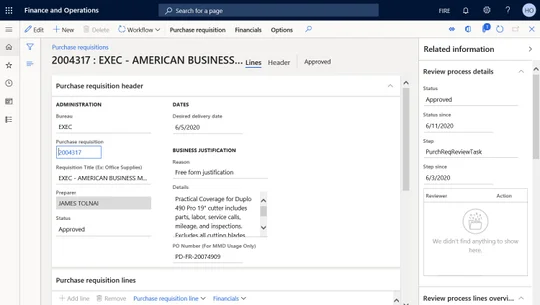
The OPRS shortened this process to under one day by allowing electronic submission/approval of requests and email notifications. The OPRS's ability to track the status of each request also provided an audit trail for timely approval and processing of all submitted requests. OPRS played an integral role in allowing the Fire Department to continue its operations during the COVID-19 pandemic by ensuring the timely processing and ordering of critical S&S needed for emergency operations personnel along with providing a platform that afforded teleworking staff the ability to submit and approve requisitions electronically.
LACoFD Telemedicine Unit (TMU)
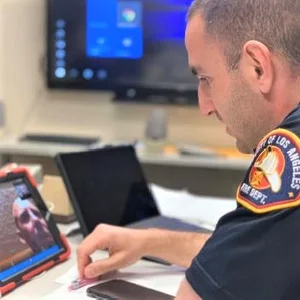
The Fire Department’s Telemedicine Unit (TMU) was built from scratch during the early days of the COVID-19 pandemic in mid-March 2020. The Emergency Medical Services (EMS) Bureau had been operating an Advanced Provider Response Unit (APRU) – partially funded with a Quality and Productivity Commission’s Productivity Investment Fund (PIF) grant as a pilot project – since November 2019. As a part of that, the framework for telemedicine access to the Medical Director had been established to support the pilot project.
With COVID-19, the APRU was transitioned to a stationary TMU, with additional funding provided through PIF grant funding, in order to provide assistance and guidance to EMS providers in the field across the entire Department, compared with the relatively small area covered by an APRU. The TMU is available to the entire Department, from 8:00 a.m. – 6:00 p.m., seven days/week. TMU has been merged into the APRU program, and a team of three EMS physicians provides support to the APRU staff and backup availability for telemedicine when the APRU is on another call for services.

Quarantine & Isolation Shelter Project
The Quarantine and Isolation (QI) Shelter Project was started in March 2020, headed by the Department of Health Services (DHS), and supported by the County Emergency Operations Center (CEOC) for County residents suffering from COVID-19 but well enough not be hospitalized. These high risk facilities were staffed with DHS contract medical personnel responsible for patient care and monitoring. Because these facilities were not hospitals or formal medical facilities, there were many unmet logistical needs and no one available to assist with the day-to-day operations.
In March 2020, as the initial facility at Dockweiler Beach was getting stood-up, a call was placed to the CEOC requesting qualified logistics personnel to assist. The Fire Department’s Lon Anderson and Patrick O’Neill were dispatched for what would be a 103-day assignment to establish 5 additional QI shelters throughout the County. They were responsible for the complete organization of the facilities, including the setup of hot, warm and cold zones; maintaining appropriate personal protective equipment levels; build out of remote nurses’ stations; development of site maps; client drop-off/pick-up areas; pre-plans for expansion, etc. Once the needs of the site were met, Lon Anderson and Patrick O’Neill maintained logistical support. At the end of their assignment, they demoblized/combined sites and preplanned for 3 additional sites on County property.